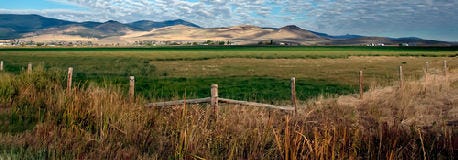
The Southern Plains have been getting mixed amounts of rain at fall wheat planting time but could offer profits to those who get wheat pasture.
Wheat pasture also appears to have has good value for stocker production this year, says Derrell Peel, Oklahoma State University extension livestock marketing specialist.
In the past month, the sharp price break against lightweight animals has moderated somewhat, although the market still favors heavier beginning stocker weights, especially for dual purpose winter grazing programs that will terminate in late February or early March.

Wheat stocker budgets look profitable and cow supplementation has good history.
For forage-only programs that will graze out wheat until May, the additional weight at the end offsets somewhat lower value of gain on the initial animal gains, Peel says. The current levels of both March and May feeder futures is sufficient to lock in values of gain that range from $1.10 to $1.35/pound.
These values suggest that winter grazing will cover a $150-$170/head grazing bill and other typical production costs and still return $70-$90/head to the cattle, Peel says.
He adds that four-weight steers could give a net return in the $20-$35/head range for winter-only grazing. Light steers grazing out wheat until mid-May may have a wheat pasture bill of $285-$310/head but still has the potential to generate $70-100/head of net return over all production costs.
Peel adds that a significant portion of wheat pasture may be used to support cows this winter, much as it did last year, since many cow-calf producers are short of pasture and hay for the winter.
Limit grazing wheat pasture combined with limit feeding hay is a good way to stretch hay supplies and minimize expensive supplemental feed needs, he says. Although more labor is required for this type of feeding program, it may be a good investment relative to hay and supplement feed costs.
Limited grazing of wheat pasture has proven to be the best and also more efficient approach for utilizing this high-quality forage with mature beef cows, adds Glenn Selk, Oklahoma State University emeritus extension animal scientist.
The protein requirements of a dry cow can be met by allowing her to graze on wheat pasture for one day and returning her to dry pasture grass or hay for two to three days. A pattern of one day on wheat and one day off should meet the protein needs of the same cow after calving, Selk says. Adequate forage must be available in the dry grass pastures or in the form of hay to provide much of the energy needs of the cows in the "off" days.
The "day on" wheat pasture should be defined as that amount of time required for the cow to graze her fill of wheat forage; three to five hours. She does not need a full 24 hours. This short time on wheat allows her to graze adequate amounts of protein to carry her over the ensuing days on dry grass or hay. The three-five hour grazing limit helps avoid unnecessary loss of valuable forage due to trampling, bedding down and manure deposits.
Under normal weather conditions in the fall, enough wheat forage should be accumulated by early December to supply the protein needs of about 1 to 1.5 cows per acre throughout the winter months when limit grazing is practiced, Selk says.
Cow-calf producers who use continuous grazing programs should watch out for the possibility of "grass tetany." as lush growth appears, Selk warns. Cows grazing lush small grain pastures should be fed mineral mixes containing both calcium and magnesium.
About the Author(s)
You May Also Like




